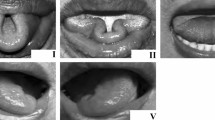Abstract
Dysphagia is a common poststroke symptom with negative effects on recovery and rehabilitation. However, the orofacial regulation therapy, developed by Castillo Morales, comprising body regulation and orofacial regulation in combination with a palatal plate application has shown promising results in stroke patients. This therapy is based not only on muscle exercises but also on an improvement of the entire sensory-motor reflex arc involved in normal deglutition, and on the knowledge that the function of face and oropharynx at deglutition is closely interrelated with the entire body posture as well as with appropriate breathing. The treatment concept is relatively unknown to caregivers, partly due to lack of scientific evaluation of treatment results. The present investigation aimed to assess the effect of motor and sensory stimulation in stroke patients with dysphagia persisting for more than six months. Seven patients were evaluated with respect to orofacial and pharyngeal motility and sensory function before and two weeks after a five-week treatment period. The evaluation comprised a swallowing capacity test, a meal observation test, clinical examination of oral motor and sensory function, a velopharyngeal closure test, and videofluoroscopy. In addition, the symptoms were scored by the patients. An overall single-blind estimation showed objective and self-assessed swallowing improvement in all seven patients. Kappa coefficients are calculated on all reliability data, both inter- and intrarater reliabilities. Sensory and motor stimulation seems to be a promising therapy in stroke patients with long-lasting and persistent oropharyngeal dysphagia.
Similar content being viewed by others
References
Castillo Morales RC, Brondo JJ, Haberstock B: Darstellung der funktion der verschiadenenen elemente des orofaxialen komplexes. InDie orofaziale Regulationstherapie, 1st ed. Richard Pflaum Verlag GmbH & Co., München: 1991, pp 21–188
Limbrock GJ, Fischer-Brandies H, Avalle C: Castillo Morales' orofacial therapy: treatment of 67 children with Down syndrome.Dev Med Child Neurol. 33:296–303, 1991
Anokhin PK: Systemogenesis as a general regulator of brain development. In: Himwich WA, Himwich HE (eds)The Developing Brain. New York: Elsevier 1964, pp 54–86
Chusid JK:Correlative Neuroanatomy & Functional Neurology. Los Altos, CA, LANGE Medical Publication, 1985
Heimer L:The Human Brain & Spinal Cord. New York, Springer Verlag, 1983
Nathadwarawala KM, Nicklin J, Wiles CM: A timed test of swallowing capacity for neurological patients.J Neurol Neurosurg Psychiatry 55:822–825, 1992
Logemann JA:Evaluation and Treatment of Swallowing Disorder 2nd ed. Pro-ed, Austin, TX, 1998, pp 91–95, 194, 195, 205–235
Landis JR, Koch GG: The measurement of observer agreement for categorical data.Biometrics 33(1):159–174, 1977
Hartelius L, Svensson P, Bubach A: Clinical assessment of dysarthria: Performance on a dysarthria test by normal adult subjects, and by individuals with Parkinson's disease or with multiple sclerosis.Scand J Logop Phoniatr 18:131–141, 1993
Hardcastle W:Physiology of Speech Production: London, Academic Press, 1976
Calhoun KH, Gibson B, Hartley L, Minton J, Hokanson JA: Age-related changes in oral sensation.Laryngoscope 102:109–116, 1992
Netsell R, Hixon TA: Non-invasive method for clinically estimating subglottal air pressure.J Speech Hear Disord 43:326–330, 1978
Han TR, Paik NJ, Park JW: Quantifying swallowing function after stroke: A functional dysphagia scale based on videofluoroscopic studies.Arch Phys Med Rehabil 82:677–682, 2001
Perkins RE, Blanton PL, Biggs N: Electromyographic analysis of the “buccinator mechanism” in human beings.J Dent Res 56:783–794, 1977
Hoyer H, Limbrock GJ: Orofacial regulation therapy in children with Down syndrome, using the methods and appliances of Castillo Morales.ASDC J Dent Child 57:442–444, 1990
Gustavsson B, Tibbling L: Dysphagia, an unrecognized handicap.Dysphagia 6:193–199, 1991
Barer DH: The natural history and functional consequences of dysphagia after hemispheric stroke.J Neurol Neurosurg Psychiatry 52:236–241, 1989
Nilsson H, Ekberg O, Olsson R, Hindfelt B: Dysphagia in stroke: a prospective study of quantitative aspects of swallowing in dysphagic patients.Dysphagia 13(1):32–38, 1998
Gordon C, Langton Hewer R, Wade D: Dysphagia in acute stroke.Br Med J (Clin Res Ed) 295:411–414, 1987
Hamdy S, Aziz Q, Rothwell JC, Power M, Singh KD, Nicholson D, Tallis RC, Thompson DG: Recovery of swallowing after dysphagic stroke relates to functional reorganisation in the intact motor cortex.Gastroenterology 115:1104–1112, 1998
Cohen H:Neuroscience for Rehabilitation. Philadalphia, JB, Lippincott, 1993
Hamdy S, Aziz Q, Rothwell JC, Crone R, Hughes D, Tallis RC, Thompson DG: Explaining oropharyngeal dysphagia after unilateral hemispheric stroke.Lancet 350(9079):686–692, 1997
Davis S: Dysphagia in acute strokes.Nurs Stand 13(30):49–54, 1999
Miller RM, Chang MW: Advances in the management of dysphagia caused by stroke.Phys Med Rehabil Clin North Am 10(4):925–941, 1999
Logemann JA: Behavioral management for oropharyngeal dysphagia.Folia Phoniatr Logop 51(4–5):199–212, 1999
Lin LC, Wang SC, Chen SH, Wang TG, Chen MY, Wu SC: Efficacy of swallowing training for residents following stroke.Adv Nurs 44(5):469–478, 2003
Ertekin C, Aydogdu I: Neurophysiology of swallowing.Clin Neurophysiol 114(12):2226–2244, 2003
Author information
Authors and Affiliations
Corresponding author
Rights and permissions
About this article
Cite this article
Hägg, M., Larsson, B. Effects of motor and sensory stimulation in stroke patients with long-lasting dysphagia. Dysphagia 19, 219–230 (2004). https://doi.org/10.1007/BF02638587
Issue Date:
DOI: https://doi.org/10.1007/BF02638587



